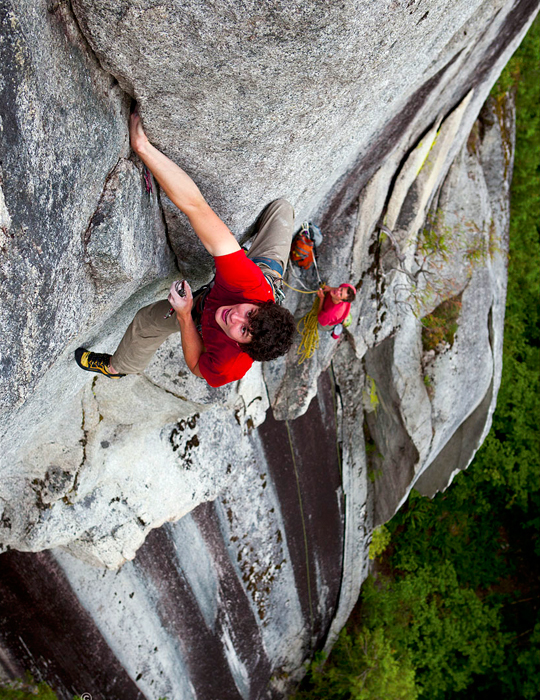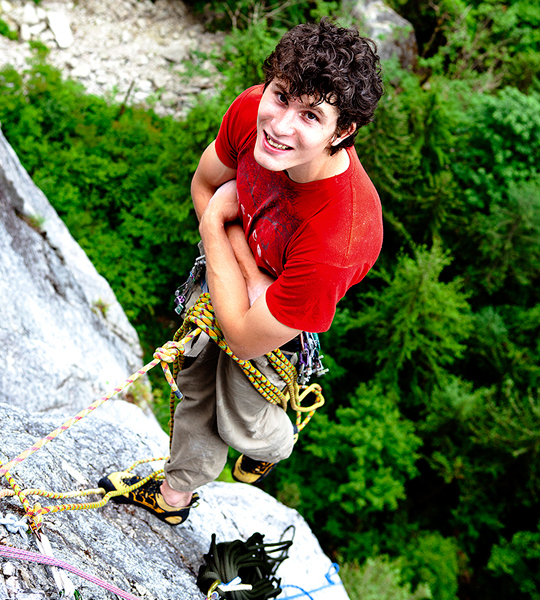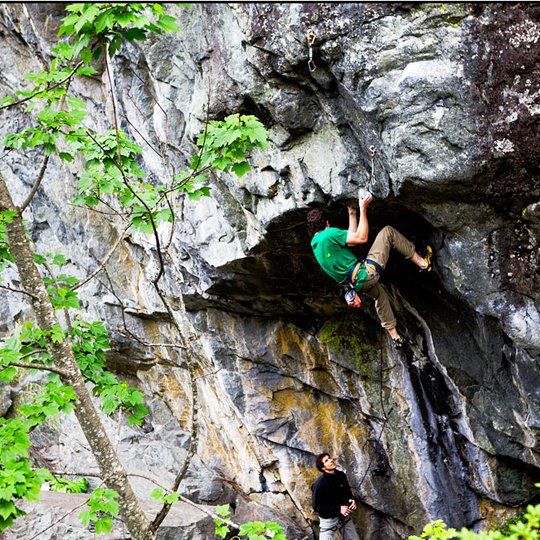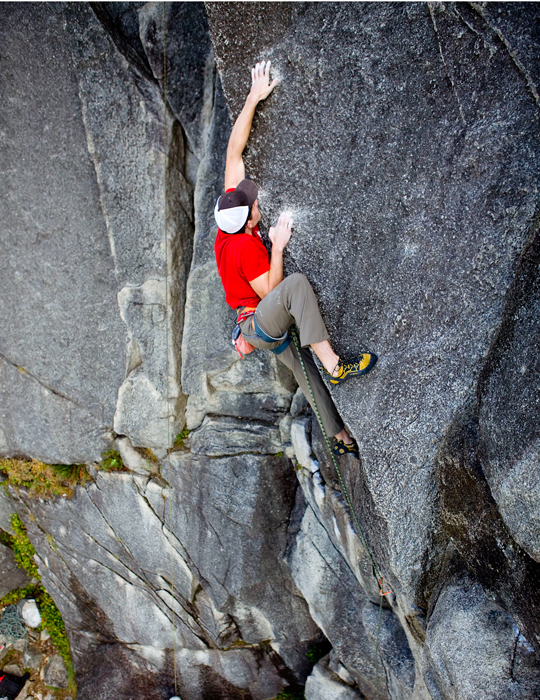
Earlier this month, twenty-year-old Squamish local Marc-Andre Leclerc free soloed and aided 32 pitches in 17 hours “house to house” on the Grand Wall of Squamish’s Stawamus Chief.
At 5 a.m. on August 5, Leclerc approached the Chief barefoot, intending to solo Apron Strings–two pitches of 5.10b laybacking and smearing–to access the Grand Wall (5.11 A0), but “it was hot and balmy,” he said, and decided on the more secure Flake route, another 5.10b layback. He finished the Grand Wall route by a bolted six-inch-wide undercling crack called Perry’s Layback and traversed the exposed Bellygood Ledge, the walk-off for many climbers exiting the Grand Wall. Upper Black Dyke (5.10b, 4 pitches) brought Leclerc to the top of the Chief.
From the top of the wall, Leclerc ran down in his climbing shoes to do his second lap up the Grand Wall via Uncle Ben’s (V 5.10c C2, 11 pitches), a 1970 Steve Sutton and Hugh Burton route that Leclerc had soloed earlier in the summer. His final lap followed University Wall (C2 [5.12a], 7 pitches), which he’d soloed this spring.
“Marc has a strong mind and has been working on strengthening his weaknesses for a long time,” says local climber Chris Geisler, who told Leclerc about the three-daisy-chain ropeless aid method that he used on parts of the linkup. “This is just the beginning. Just warming up, before Marc actually knows what he’ll truly be able to accomplish.”
The following is an interview we had over the phone while Marc-Andre was walking outside his home in Squamish and I was in Golden, Colorado.
When did you start working on your solo systems?
I got really psyched when I was pretty young–15. It was hard to find partners sometimes. I had six-pitch routes near where I went to high school. I would try multipitch routes alone, figuring it out as I went. There are tricks people do to solo walls more quickly. I taught myself these tricks.

What techniques did you use?
I combined free soloing, rope soloing and ropeless aid using three daisy chains.
How did you pace yourself or take rests?
On the Grand Wall there are a lot of natural ledges. If I’m free soloing I’ll find natural rests. I don’t want to power through and make myself pumped…. I (also) took some breaks between climbs. I ran into friends and sat down. Ate food and would re-rack.
What gear did you carry on the link-up?
A harness with three daisies and had a few slings so I could extend the draws and stand in the slings. On the bolt ladders I would pull on quickdraws. When I was free soloing I was wearing my rock shoes. When I was in aiders I was in my tennies.
What inspired you to do it?
After a week-long visit to Yosemite Valley I came back to Squamish and the walls didn’t seem that committing.
What was your crux?
The crux really, is switching headspace as you switch styles of climbing. It’s super fun. I like pitching it out aid climbing but moving quickly. You fix your rope, zip down super fast. Unclip from the belay and jug the free hanging rope. And enjoy the exposure.

What goes through your mind when you’re switching between free solo and aid soloing?
When I am at an aid crux it feels like I’m rigging a stunt. I’ll double-check my system, assess the fall and be OK with it and move piece to piece. For unroped aid climbing I employ three daisy chains, but only on straightforward sections: If you’re on three one-inch cams it seems pretty safe to me. When it got thinner I got so meticulous it was slower than doing it on belay.
As soon it was overly meticulous I would self-belay fast. I am quite tall and have a positive ape index. I’ll top step and place an intermediate piece and make like an eight-foot move and climb really fast. When it gets thin like that it’s too sketchy to save time.
Did you ever feel like you were pushing it too hard and could be killed?
The only part that felt dicey on the linkup was at the end of the University Wall. It was a .10+ pitch. I was aiding across on fixed pins in horizontals. I was back cleaning, and there’s a move where you have to pull on this old rusty fixed pin to reach the belay. I had no protection in for 60 feet back to the belay and junk to hit. I bounce-tested the pin to make sure it wouldn’t pull. I put a quickdraw on it and used it as a handhold. It was over in about a second. It was the only time on the linkup that I felt a little beyond my control.
Even free soloing a 5.11 crack it feels more like under your own control than yarding on a fixed piece of mank.
